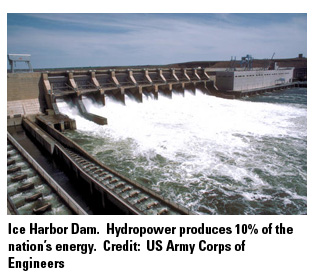 Hydropower in the United States can generate enough electricity for 28 million households, the equivalent of nearly 500 million barrels of oil - or just over 7 percent of the Nation's electricity needs. Hydro is the Nation's leading renewable energy resource and is free of greenhouse gas emissions. It has long been a dependable source of electricity and serves a vital role in the Nation's energy portfolio. Approximately 54 percent of the hydropower produced in the United States is licensed by the Federal Energy Regulatory Commission. FERC authorizes the initial construction of non-Federal hydropower projects and reconsiders licenses every 30 to 50 years. The remainder is produced by the Federal Government, largely by the Corps of Engineers, the Tennessee Valley Authority and the Department of the Interior's Bureau of Reclamation. Hydropower in the United States can generate enough electricity for 28 million households, the equivalent of nearly 500 million barrels of oil - or just over 7 percent of the Nation's electricity needs. Hydro is the Nation's leading renewable energy resource and is free of greenhouse gas emissions. It has long been a dependable source of electricity and serves a vital role in the Nation's energy portfolio. Approximately 54 percent of the hydropower produced in the United States is licensed by the Federal Energy Regulatory Commission. FERC authorizes the initial construction of non-Federal hydropower projects and reconsiders licenses every 30 to 50 years. The remainder is produced by the Federal Government, largely by the Corps of Engineers, the Tennessee Valley Authority and the Department of the Interior's Bureau of Reclamation.
Hydropower is not free of environmental impacts, and while it is an important source of energy, hydropower projects need to include environmentally sound measures that provide for the protection and enhancement of the Nation's natural resources. The Fish and Wildlife Service conserves, protects, and enhances fish and wildlife resources through a variety of programs, including environmental review of Federal and non-Federal hydropower licenses, to incorporate appropriate environmental protection and enhancement measures.
Future Opportunities - Hydropower is a component of a national energy strategy that seeks to rely on clean, efficient, and safe energy sources. To meet this need, hydropower projects designed in an environmentally sound manner will ensure that the Nations natural resources are protected. The Service continues to work with licensees, applicants, FERC, and other agencies in the design and licensing of hydropower projects. The public also has a role in this process. Comprehensive watershed planning in cooperation with State and local agencies and private organizations are essential to the future conservation and development of the Nations rivers and fish and wildlife resources.
|